Interesting Facts About Niagara Falls
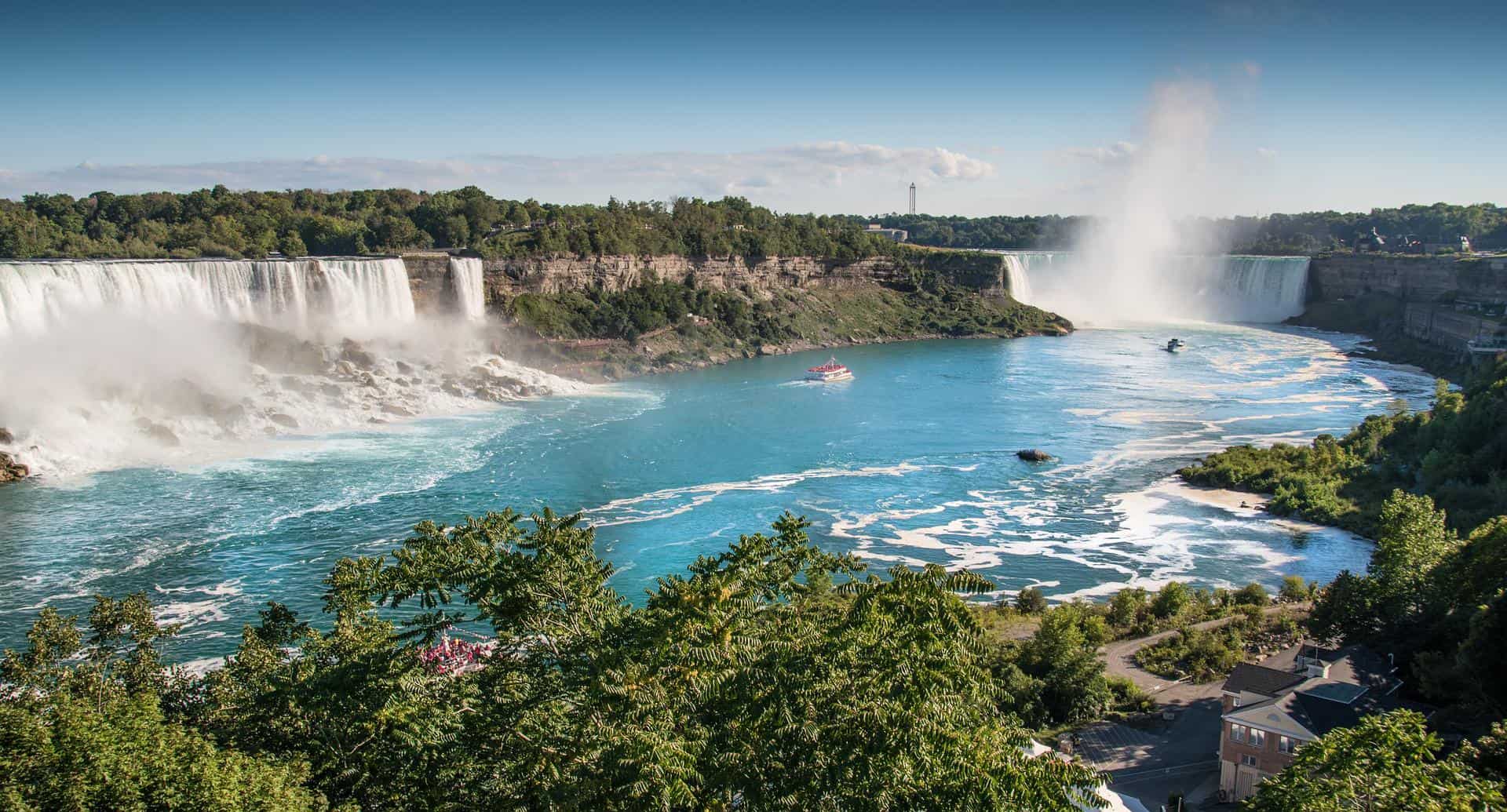
Updated On: November 08, 2023 by Marwa Alaa
“Niagara Falls is one of the finest structures in the known world,” according to Mark Twain. Niagara Falls has iconic three waterfalls of the same name, considered one of the Earth’s natural wonders. Besides the waterfalls, many attractions are worth visiting on both the Canadian and American sides. Let’s explore some fun and interesting facts about Niagara Falls and delve into its history.
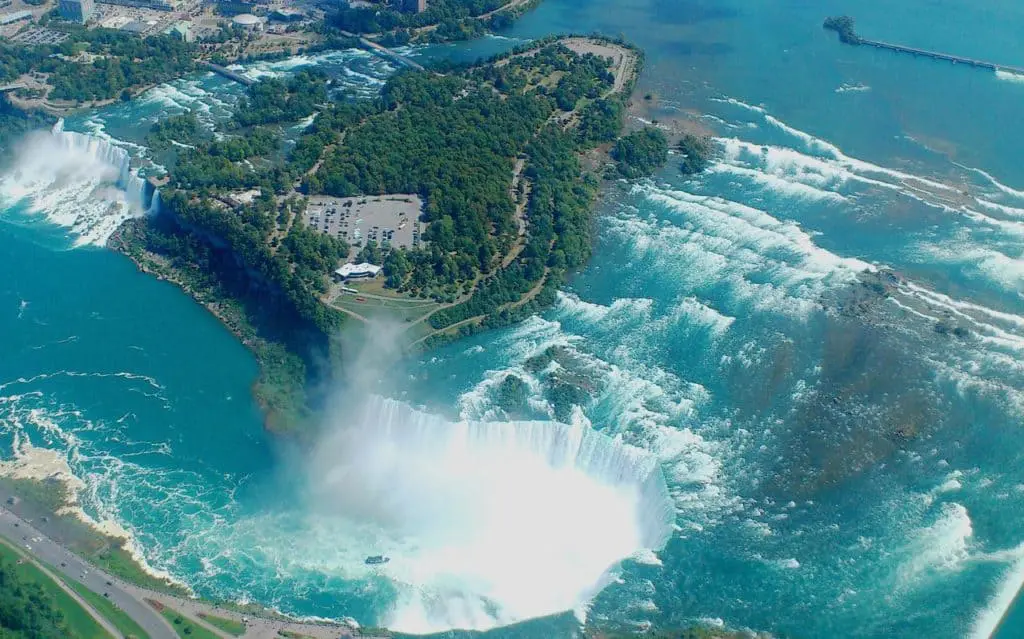
History of Niagara Falls
Niagara Falls comprises three waterfalls: Horseshoe Falls (or the Canadian Falls), American Falls, and Bridal Veil Falls. It has a lot of interesting and fun facts. However, let’s explore its history first before we display these facts.
Why is Niagara Falls Famous?
Niagara Falls has been a significant tourist attraction for the past 200 years. It is famous for its monumental three waterfalls on the Niagara River’s western shore and the Niagara Gorge’s southern side. This iconic group of waterfalls is a major source of hydroelectric power in Canada and America.
Although Niagara Falls is not the world’s tallest waterfall, it is known for having the highest flow rate. About 28 million litres of water (over 700,000 gallons or 3160 tons) per second pour over Niagara Falls from its crest line during the peak periods in Summer and Autumn.
One of the facts about Niagara Falls is that it is known to have the fastest-moving waterfalls in the world. Its water rushes at approximately 35 miles/hour (56.3 kilometres/hour). This allows six million feet3 (around 168,000 meters3) of water to cascade at its crest every minute.
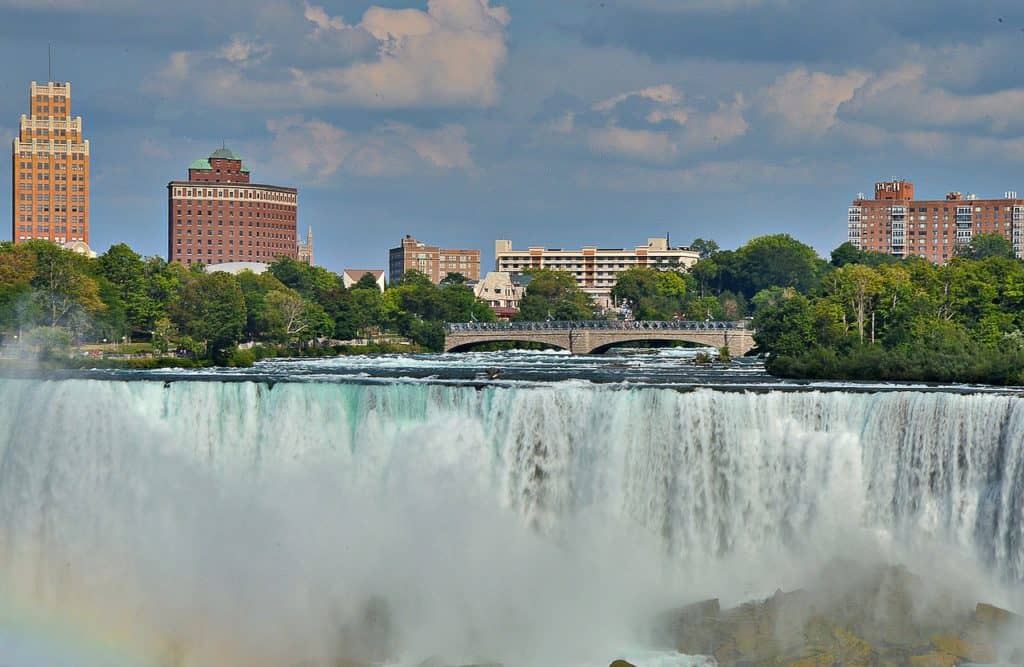
How Was Niagara Falls Formed?
So why doesn’t the water from Niagara Falls erode the falls and smooth them out? Here is the answer. Two-mile-thick continental glaciers covered the Niagara Frontier region during the last Ice Age, around 1.7 million years ago. About 12,500 years ago, the Niagara Peninsula was ice-free, and glaciers started to recede. The melted glaciers formed the Great Lakes: Lake Erie, Lake Michigan, Lake Huron, and Lake Superior.
These Upper Great Lakes drained into the Niagara River, carved out by the rushing water. At a point, the river passes over a steep cliff-like formation that does not slope at even grade, thus forming a spectacular drop known as the Niagara Escarpment. Finding a low-lying pathway, the river then cascades down the cliff, travels around 15 miles over many gorges, and empties into Lake Ontario. In short, the Niagara River connects Lake Erie and Lake Ontario, forming Niagara Falls.
How Long Will Niagara Falls Last?
From Lake Erie, five spillways were reduced to one, now the original Niagara Falls. This spillway was at Queenston-Lewiston, where the falls started their steady erosion. The brink slowly eroded the bedrock, receding three to six feet yearly. Within the past 10,000 years, the Falls reached its current location. Niagara Falls extended seven miles downstream from where it is today. Now, the erosion continues to push Niagara Falls upstream, meaning that Niagara Falls goes its way back.
In 1950, Canada and the United States established the Niagara River Water Diversion Treaty to control and limit the amount of water and slow erosion. Ontario Hydro and the New York Power Authority keep the flow’s volume at 100,000 ft3 per second from April to October, which is a tourist season. However, they reduce it to 50,000 ft3 per second at night to increase power generation intake. With the current erosion rate of approximately one foot per year, it is thought that the Niagara River will erode and Lake Erie will drain after tens of thousands of years.
Is Niagara Falls Saltwater or Freshwater?
One of the important facts about Niagara Falls is that the four Upper Great Lakes provide freshwater. 20% (one-fifth) of the world’s freshwater lies in the Great Lakes. It also provides the US with drinking water because 84% of North America’s surface freshwater is there.
Nevertheless, this does not mean you can drink water directly from Niagara Falls. The water might be contaminated with bacteria and parasites and should be purified for drinking. Take care!
Who Discovered Niagara Falls?
Between AD 1300 and 1400, Onguiaahra settled in this area. Onguiaahra, which French explorers turned into Niagara later, was one of the first Native tribes that settled there. Then came the Iroquois group, the Atiquandaronk. The French explorers called them the Neutrals because of their efforts in keeping peace among the neighbouring warring tribes.
The first European to visit Niagara Falls was Étienne Brûlé in 1626. He was a French explorer who lived among the Neutrals. He did not record this incident; however, he reported it to his patron Samuel de Champlain. De Champlain wrote about Niagara Falls for the first time. Later, he drew and published a map of Niagara in 1632.
The first actual documentation of Niagara Falls was in 1678. Father Louis Hennepin was the first one to describe the falls in depth. He was a French priest who accompanied the French explorer Robert de La Salle on his expedition to Niagara Falls.
20 Quick Facts About Niagara Falls
The following are some quick facts about Niagara Falls:
1. How Large is Niagara Falls?
Among the interesting facts about Niagara Falls is that it consists of three separate waterfalls: Horseshoe Falls (or Canadian Falls), American Falls, and Bridal Veil Falls. While the Canadian Horseshoe Falls is about 51 metres (167 feet) high and 823 metres (2700 feet) wide at its crest, the American Falls is between 27 and 36 metres (90 and 120 feet) high and 286.5 metres (940 feet) wide at its crest. Like the American Falls, Bridal Veil Falls drops between 27 and 36 metres (90 to 120 feet); however, it stretches over 14 metres (45 feet) across at its crest.
2. How Deep is the Water at the Bottom of Niagara Falls?
One of the facts about Niagara Falls is that the average water depth below Niagara Falls equals the height of the falls itself. It is around 52 metres (170 feet) deep.
3. Which is Bigger, Victoria Falls or Niagara Falls?
Victoria Falls is 1708 metres (5604 feet) wide and 108 metres (354 feet) high. On the other hand, Niagara Falls has an entire width of 1204 metres (3950 feet) and a height of 51 metres (167 feet). This shows that Victoria Falls is half a kilometre wider than Niagara Falls and almost double its height. In light of the above, Victoria Falls in Southern Africa has the largest sheet in the world and then comes Niagara Falls in North America. However, in North America, Niagara Falls is the largest waterfall by width and volume.
4. Is Niagara Falls in Canada or America?
Straddling the Canadian-American border, Niagara Falls comprises three waterfalls. The largest waterfall is Horseshoe Falls, also known as the Canadian Falls. Smaller than Horseshoe Falls is American Falls. Between the Canadian and American Falls is the smallest waterfall of Niagara Falls, Bridal Veil Falls.
5. Niagara Falls Canada vs Niagara Falls America
People usually ask, “is it better to view Niagara Falls from the US side or the Canadian side?” Well, the answer is the Canadian side has gorgeous panoramic views, which are more glamorous than the American side.
Enjoy the mesmerising views of the waterfalls and the magnificent constant haze of vapour and spray. Also, admire the turquoise water and the surrounding greenery while listening to the charming music of the water cascading down the rocks.
6. Why is the Water at Niagara Falls Green?
Among the exciting facts about Niagara Falls is that the waterfalls are sometimes startling green. This brilliant hue is a visual illustration of the erosive power of water. Every minute, Niagara Falls sweep an estimated 60 tons of dissolved minerals. The vibrant green colour comes from the dissolved salts and very finely ground rock from the limestone bed, shales, and sandstones.
7. Niagara Falls At Night | Is Niagara Falls Worth Visiting in the Middle of the Night?
One of the facts about Niagara Falls is that it is worth a stop at night. From dusk to midnight, enjoy the breathtaking views of Niagara Falls with different shades of colour. The falls are illuminated by intense colourful spotlights, resulting in a magical landscape.
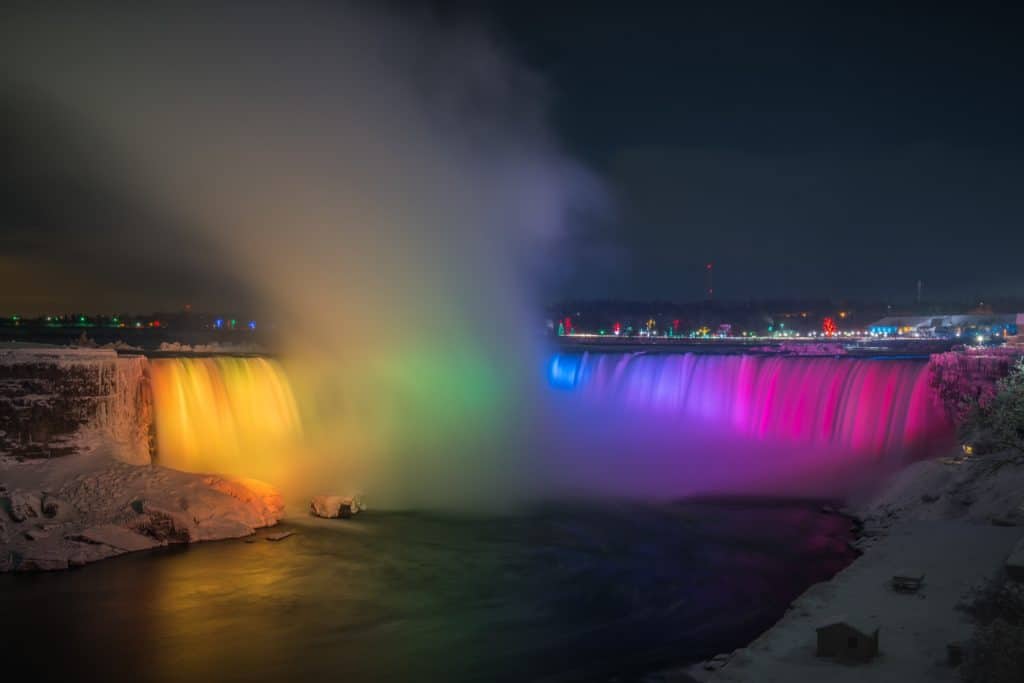
8. Are There Tunnels Under Niagara Falls?
One of the most exciting things to do in Niagara Falls is to take a Journey Behind the Falls. It was known as the Scenic Tunnels until the early 1990s. Beneath Niagara Falls lies ten storeys of a maze of massive tunnels. Descend 38 metres (125 feet) under the raging water and explore the 130-year-old tunnels through the bedrock. You will feel the roaring vibration of the water flowing over the cliffs and enjoy yourself to the max!
9. Facts About Niagara Falls: Location and How to Reach it
Niagara Falls exists in the Canadian province of Ontario and the American state of New York. The exact Niagara Falls coordinates are 43.0896° N and 79.0849° W.
There is an airport near Niagara falls called Buffalo Niagara International Airport (BUF) that hosts around 100 non-stop flights per day. Flying to Buffalo is a perfect choice to visit Niagara Falls. Then, you can take a taxi, bus, or car to Niagara Falls. It takes approximately a 45-minute drive from Buffalo, NY, to Niagara Falls, Ontario.
Another airport near Niagara Falls is Toronto Pearson International Airport in Toronto. It has many flights from where you can pick up one to travel to Niagara Falls. Then, taking the bus from Toronto to Niagara Falls, Ontario, is economical. It takes around two hours driving without traffic delay. You can also take the train to Niagara Falls from Toronto. The journey takes about two hours. Additionally, a trip from Windsor, Canada, to Niagara Falls takes approximately four hours driving.
You can also go to Niagara Falls from Boston or New York by plane, bus, car, or train. It takes approximately seven hours and 20 minutes by car from Boston to Niagara Falls. However, it takes only seven hours from New York to Niagara Falls. The journey from Rochester, NY, to Niagara Falls by car is approximately one hour and 30 minutes.
10. Which City in Canada is Closest to Niagara Falls?
The Canadian side of Niagara Falls is in Ontario. The closest Canadian city to Niagara Falls is Hamilton, which is at a distance of around 68 km2. Toronto is a bit farther at a distance of approximately 69 km2.
11. Which US City is Closest to Niagara Falls?
On the other hand, the American side of Niagara Falls is in New York. The closest American city to Niagara Falls is Buffalo. It is approximately 27 km2 southeast of Niagara Falls.
12. Can You Walk Over the Border to Canada or New York?
Yes, you can walk over the border to Canada or New York. Crossing Rainbow Bridge, the Canadian-American border, is available 24/7 daily. You can cross it on foot, by bicycle, or by car.
Can you Walk Across the Rainbow Bridge Without a Passport?
Rainbow Bridge is a usual international border crossing operated by Canada and the USA. However, you cannot walk across the bridge without a passport. To walk on the bridge or visit the other country, you must have a valid passport and visa. Otherwise, the immigration office there will deny your access.
13. Facts About Niagara Falls: Time
Time in Niagara Falls is five hours behind Coordinated Universal Time (UTC -5). From mid-March to early November, the Daylight Saving Time becomes UTC -4. There is no time difference between New York and Canada.
14. Facts About Niagara Falls: Weather
One of the facts about Niagara Falls is that the temperature ranges from 14°C to 25°C in Summer. That is your sunscreen and sunglasses are essential.
In Winter, the average temperature fluctuates between 2°C and -8.2°C. If you travel to NiagaraFalls in Winter, take a heavy jacket, a scarf, gloves, winter boots, and heavy clothes.
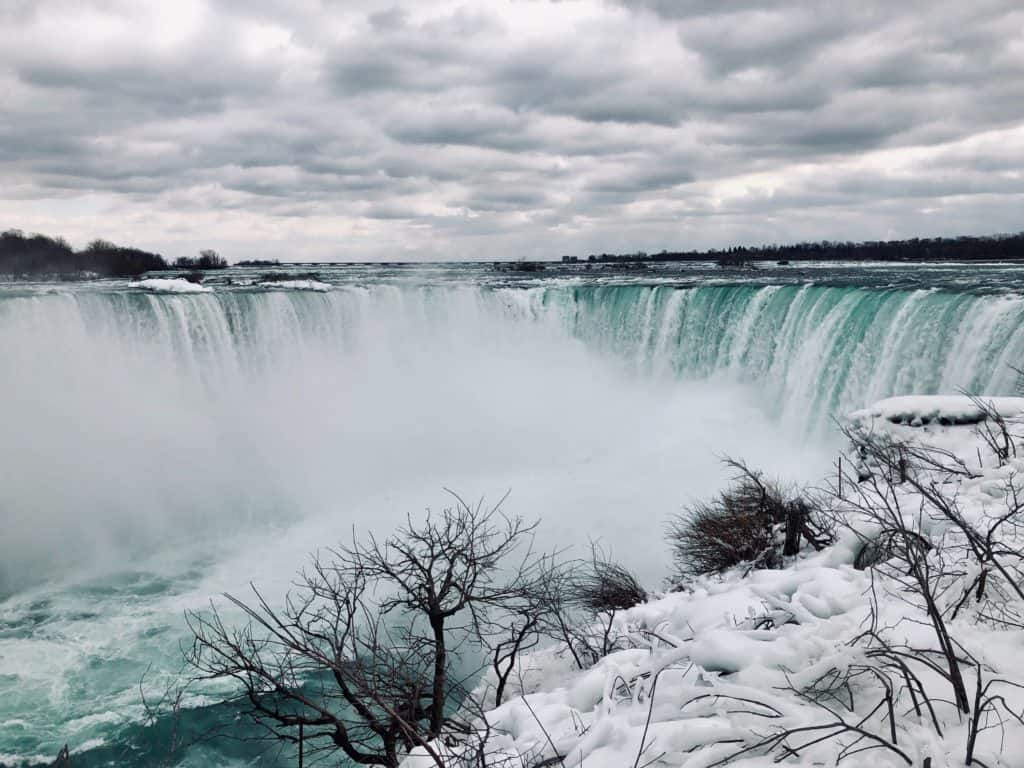
What is the Best Time of Year to Visit Niagara Falls?
June to August is the best time when you can visit Niagara Falls. If you love cold weather and want to visit Niagara Falls in Winter, the magical time to travel there is from late December or January to February.
Is it Advisable to Visit Niagara Falls in Late November?
Niagara Falls in November is chilly but without snow. Snow falls in December or January. However, you can still visit Niagara Falls in late November and enjoy your vacation since there will be no crowds.
Is Niagara Falls Fun in the Winter?
Travelling to Niagara Falls in winter is magnificent if you can endure the freezing cold. Bring your coat with you so you can do many winter activities there. Enjoy the stunning views of the waterfalls and snap many photos with your camera!
15. Does Niagara Falls Freeze Over in Winter?
Well, the falls might look frozen, but they are actually not. Snow covers everything around the falls. The spray and mist coming off the falls form a thin crust of ice over the top of the rushing water. These breathtaking views might look as if the falls are frozen to your eye.
Although an ice jam caused Horseshoe Falls to stop flowing, the Falls itself does not freeze due to the high volume of water. On the other hand, American Falls has a lower volume of water. Thus, it is more likely to be frozen at a very low temperature, and ice could build up, causing an ice dam that reduces the water flow. That is why any small amount of water there may freeze. Recently, an ice boom, a long chain of steel floating across the Niagara River, has been installed to prevent the ice from clogging the river.
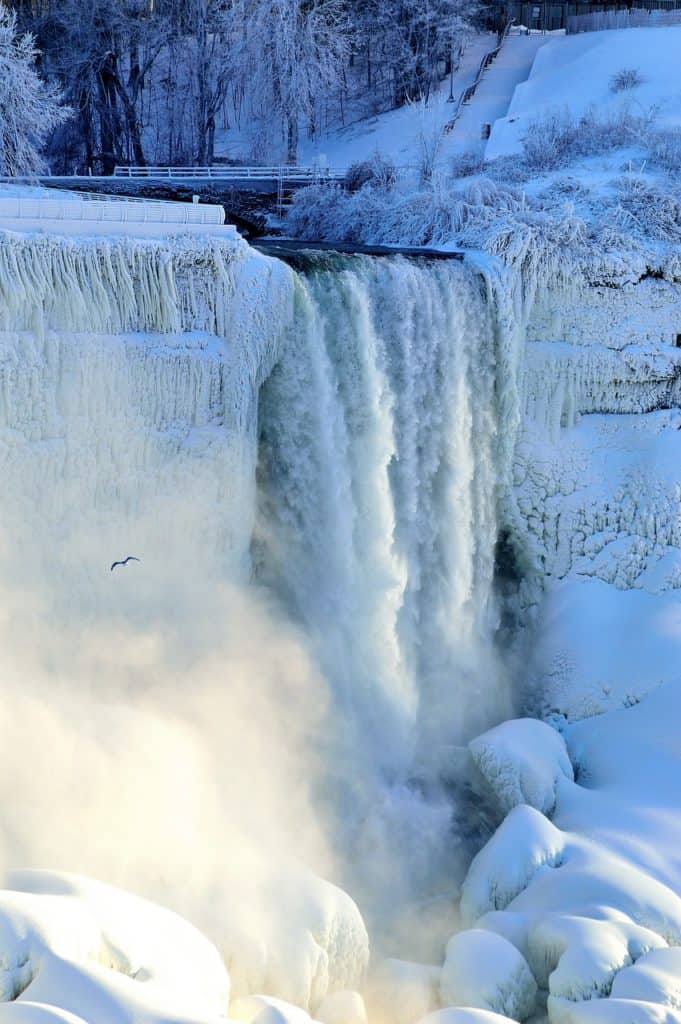
16. Why Did They Turn Off Niagara Falls?
As we mentioned beforeِ, the Canadian Horseshoe Falls stopped flowing entirely for 30 to 40 hours due to an ice jam at the Niagara River’s mouth in Fort Erie, Ontario, on March 1848. The river did not freeze, but the ice just plugged it. When this happened, people recovered some artefacts from the riverbed.
One of the facts about Niagara Falls is that the US Army Corps of Engineers built an earthen dam across the head of the American Rapids in 1969, trickling the American Falls for several months, from June to November. During these six months, engineers and geologists studied the effects of erosion and the rock face. It was to determine whether they could remove a rock formation from the base of the waterfalls to enhance its appearance. Finally, they decided to leave it to nature because the expenses would be too costly.
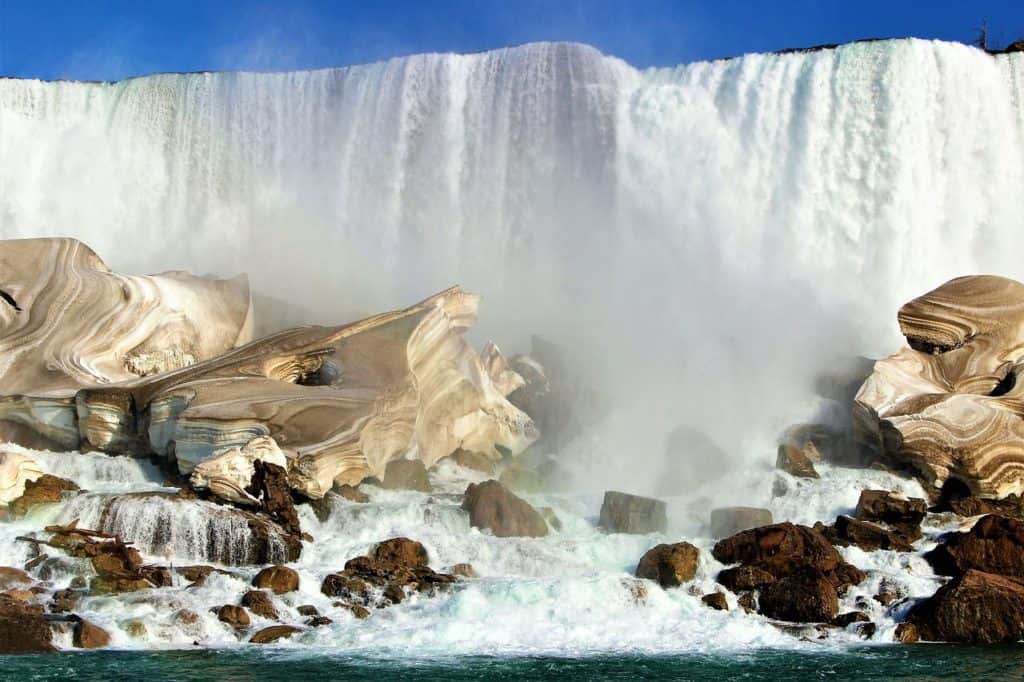
17. What was Found at the Bottom of Niagara Falls When They Drained it?
When the falls stopped flowing in 1969, they found millions of coins at the bottom of Niagara Falls, along with two dead bodies and human remains.
18. Facts About Niagara Falls’ Fauna: Animals
Niagara Falls and its surrounding area are home to a wide variety of wildlife, including birds, amphibians, reptiles, and mammals. It has more than 1250 animal species, including 53 species of mammals, 36 species of reptiles, 17 species of amphibians, and 338 species of birds.
In Niagara Falls, you will find red squirrels, fox squirrels, grey treefrogs, boreal chorus frogs, Spring peepers, fowler’s toads, and American toads. In Ontario, a quarter of Canada’s endangered species are in the Niagara Escarpment World Biosphere Reserve, which includes vulnerable southern flying squirrels, Jefferson salamanders, rare eastern pipistrelle bats, and eastern massasauga rattlesnakes.
Why Are There Black Squirrels at Niagara Falls?
When fox squirrels interbreed with grey squirrels, they produce species with black fur. There are no historical records of black squirrels in Niagara Falls in the early 1800s. According to urban legends, there were no black squirrels in Niagara Falls, USA. However, black squirrels were found across the Niagara River in Canada at this time.
Legends say the first suspension bridge was built across the river. When the bridge’s avenue was open, black squirrels crossed the river to the USA. Whether this story is true or false, you can still see this lovely fur creature in Niagara Falls, Canada, if you have a sharp eye.
Are There Frogs at Niagara Falls?
In Spring, you will find loads of frogs and toads, especially in the Niagara Escarpment. For example, there are seven species of treefrogs in Canada, including cope’s grey treefrogs and boreal chorus frogs. The only smaller frog found in Niagara Falls is the Spring peeper.
Are There Crocodiles in Niagara Falls?
Generally, crocodiles live in salt water and, as we mentioned before, Niagara Falls is a source of fresh water. Welland, a city in the municipality of Niagara, was home to a pair of endangered crocodiles for over 20 years. They were known as Orinoco crocodiles. There has been reports of crocodiles in Niagara Falls in the past but sightings have been extremely rare.
Facts About Niagara Falls’ Avifauna: Bird Fauna
In Niagara Falls, there are 338 bird species. If you are a bird watcher, you will enjoy the fantastic bird species you will see at Beamer Conservation Area in Grimsby, the highest point of the Niagara Escarpment. Furthermore, you will appreciate the bird species in the Niagara River Corridor, the world’s first internationally-recognised area. In 1996, Audubon designated this area as an Important Bird Area (IBA).
Observe common bird species, like robins, green herons, blue jays, woodpeckers, Canadian geese, and gulls. Nineteen species of gulls live there, including great-black-backed, Sabine, Iceland, and Franklin’s gulls. In addition, you can find warblers that delight you with their enchanting singing, such as black-throated blue, chestnut-sided, and yellow-rumped warblers.
There are also thousands of waterfowl and wintering gull species in the Niagara River. In addition, the river supports many protected bird species of New York, including American bald eagles and peregrine falcons.
Facts About Niagara Falls’ Piscifauna (or Ichthyofauna): Fish Fauna
There are more than 60 fish species in the Niagara River. The species include canvasbacks, smallmouth bass, rock bass, and yellow perch. In the upper Niagara tributaries, you will find periodic large migratory runs of fish species, including gizzard shads, emerald shiners, and spottail shiners or minnows. However, the Lake Sturgeon, one of New York’s endangered and protected fishes, live in the lower Niagara River.
In fact, fish plunge over Niagara Falls. About 90% of them survive due to their ability to flow with water. Their bodies are designed to survive the steep drop. Also, the foam formed when the water drops cushions their fall. Anyway, those who escape the circling get caught by seagulls.
19. Facts About Niagara Falls’ Flora: Plants
Niagara Falls and its surrounding area have hundreds of rare flora species, like wild orchids. It is home to 734 species of plants, including tulip trees, red mulberries, black walnuts, sassafrases, and flowering dogwoods. More than 70 species of trees are in the region, like hemlock trees, evergreen pines, cedar, and spruce.
There are also 14 rare plant species in the Niagara River Gorge. Some of these plants are endangered and threatened. In addition, over 600 flora species have grown on Goat Island over the last two centuries. Among them are 140 tree species that are native to western New York.
20. Facts About Niagara Falls and Generating Electricity
In Niagara Falls, Nikola Tesla and George Westinghouse created the first hydroelectric power plant in the world in 1885. In 1893, they diverted water to the Canadian Niagara River to generate electricity for the first time.
Under an international treaty, authorities reduce the water flow over Niagara Falls at night to increase the power generation intake. Actually, 50 to 75% of the water flow is diverted to hydroelectric power plants. Reducing the water flow at night also maintains the natural beauty of Niagara Falls during prime viewing hours in the morning. Hydroelectric power plants also divert less water in Summer to increase the water flow over Niagara Falls for visitors and make it appear more enchanting and magical.
Due to the enormous water flow in terms of speed and volume, Niagara Falls generates 4.9 million kilowatts of electricity. This large amount of electricity is enough to supply about one-fourth (25%) of the power used in New York and Ontario (as many as 3.8 million houses).
The power plants of Sir Adam Beck 1 and Sir Adam Beck 2 generate hydroelectricity from redirected water. This hydroelectricity supplies Western New York and Southern Ontario, especially communities in Chippawa and Queenston. Several other hydroelectric power plants in Niagara Falls and its surrounding area produce electricity for all of America and Canada.
In November 1896, electrical power was transmitted from the Adams Power Plant in Niagara Falls, New York, to Buffalo, New York. This was the first time in the world when the alternating current was transmitted over a long distance.
25 Interesting Facts About Niagara Falls
Here are some interesting Niagara Falls facts:
1. Heavenly Niagara Falls
What makes Niagara Falls mesmerising is its height and speed of the water flow. Every second, 3160 tons of water flow over Niagara Falls. This means that 75,750 gallons of water flow over American Falls and Bridal Veil Falls every second, while 681,750 gallons of water flow over Horseshoe Falls every second.
One of the facts about Niagara Falls is that the water cascades over Niagara Falls at 32 feet per second. This means that the water hits the base of American Falls and Bridal Veil Falls with 280 tons of force while it hits the base of Horseshoe Falls with 2509 tons of force.
2. Facts About Niagara Falls’ Enchanting Sound
Due to the massive amount of water cascading down the cliffs and landing at the bottom, Niagara Falls has a thunderous magical sound that enchants you.
3. Facts About Niagara Falls State Park
Niagara Falls State Park is the official state park in New York and the oldest in the United States. It includes American Falls, Bridal Veil Falls, and a part of Horseshoe Falls. This state park has maintained and protected Niagara Falls’ surrounding area. In the past, private enterprises owned it; however, they limited public access. The government then purchased it to protect the Falls and its surrounding area from the exploitation of private enterprises.
Stretching over 400 acres with approximately 140 acres underwater, Niagara Falls State Park was established as the Niagara Reservation in New York in 1885. The one who designed it was Frederick Law Olmsted, who also designed Central Park in New York City. Niagara Falls State Park is the first reservation that became the cornerstone of the New York State Office of Parks, Recreation and Historic Preservation.
4. Niagara Falls and Chief Clinto Richard
In Niagara Falls State Park, you can find a statue of Chief Clinto Richard, the founder of the Indian Defence League in 1926. The statue is near the Great Lakes Gardens in the Welcome Plaza at Prospect Park.
5. Facts About Niagara Falls and Goat Island
Goat Island is also a fantastic destination that is worth visiting in Niagara Falls State Park, New York. It has the statue of Nikola Tesla, a Serbian-American inventor. Before becoming a part of Niagara Falls State Park, Cornelius Vanderbilt, an American business magnate nicknamed the Commodore, planned to make Goat Island a pleasure ground for visitors riding his trains to Niagara Falls. On the other hand, Phineas Taylor Barnum (P. T. Barnum), an American showman, fought heavily to turn Goat Island into one of the country’s largest circus grounds.
6. Facts About Niagara Falls and Green Island
Between Goat Island and the mainland of Niagara is Green Island. Although it is pretty expensive, it is a beautiful place that is worth visiting. One of the most exciting things to do on Green Island is snorkelling. You can also relax on one of its lovely beaches. Do not also miss visiting the crocodile attraction there.
Green Island was named after Andrew Green, the first president of the commission at the State Reservation at Niagara. Considered the Father of Greater New York, Green led the movement of Greater New York that joined Manhattan Island and the municipalities around it into the five-borough city we see now. He also assisted in establishing critical cultural institutions, like the Metropolitan Museum of Art, the Bronx Zoo, and the Museum of Natural History.
7. Facts About Niagara Falls and Three Sisters Island
Three Sisters Island was named after Asenath, Angeline, and Celinda Eliza. They are the daughters of General Parkhurst Whitney, an American commander during the War of 1812. Whitney then became a prominent businessman and owned the Cataract Hotel in Niagara Falls, New York.
8. Niagara Parks Butterfly Conservatory
The Butterfly Conservatory is one of North America’s largest glass-enclosed conservatories. It has over 2000 vibrantly coloured tropical butterflies that fly freely over greenery and exotic blossoms. It also has trickling waterfalls and lush vegetation. This conservatory is a welcome addition to Niagara Falls’ growing list of attractions. There, you can unwind, relax, and appreciate the astonishing landscape.
9. Facts About Niagara Falls and Energy
Authorities harnessed the Niagara River’s energy for hydroelectric power generation in the mid-18th century.
10. Facts About Niagara Falls, Canada, in the Past
Niagara Falls was an early settled and active area in Canada’s formative years.
11. Facts About Niagara Falls’ Historical Sites
Niagara Falls has many significant historical sites. It has the historic Village of Lewiston, where the first battle of the War of 1812 occurred. The village also was the last stop for enslaved people who were escaping to freedom because it had the Underground Railroad.
12. Facts About Niagara Falls and the War of 1812
The War of 1812 had many battles that took place from 18 June 1812 to 17 February 1815. The bloodiest and costliest battle occurred on 25 July 1814 at Lundy’s Lane in Niagara Falls, Ontario. In this battle, the British suffered heavy casualties, including 950 dead, wounded, or captured, whereas the American casualties were light, with 84 dead or wounded.
13. Facts About Niagara Falls and the Original Flight of Five Locks
Along the Erie Canal in Lockport exists the original Flight of Five Locks, a device for lifting and lowering boats. On all US-built canals, this device still provides the highest lift in the shortest distance.
14. Niagara Falls and the Oldest United States Flag
Old Fort Niagara displays one of the oldest surviving United States flags captured during the War of 1812 by the British.
15. Facts About Niagara Falls and the Minolta Tower
The Minolta Tower is 325 feet higher than the Horseshoe Falls. From its observation deck, you can view Niagara Falls from the Canadian side. It also has a wedding chapel with Niagara Falls in the background.
16. Facts About Niagara Falls and Skylon Tower
One of the interesting facts about Niagara Falls is that Skylon Tower is 775 feet higher than Niagara Falls. It offers a revolving dining room with a summit suite buffet so that you can enjoy the mesmerising views of Niagara Falls while you are eating.
17. Blondin and His High-Wire Tightrope Acts Over Niagara Falls
High-wire tightrope performances were being performed across the Niagara River. In June 1859, Charles Blondin, a French acrobat and funambulist (a tightrope walker), did the first tightrope walk. He crossed the Niagara Gorge several times (an estimate of 300 times) on a tightrope on the Canada-US border near the current location of Rainbow Bridge. The tightrope was 340 metres (1,100 feet) long, 8.3 centimetres (3.25 inches) in diameter, and 49 metres (160 feet) above the water.
18. Blondin and His Other Daredevil Stunts Over Niagara Falls
One of Blondin’s famous crossings was when he carried his manager Harry Colcord, a 148-pound (67 kg) man, across on his back! Several times after that, he did endless stunts on the high-wire. This included crossing blindfolded, carrying a cooking stove and stopping midway to prepare an omelette and get some rest, trundling a wheelbarrow, standing on a chair with only one of its legs balanced on the rope, crossing in a sack, and crossing on stilts.
19. Wallenda, the King of the High-Wire
Similarly, Nik Wallenda, an American Acrobat, successfully crossed Niagara Falls on a tightrope in June 2012. He was the first to walk directly over Niagara Falls on a tightrope in front of tens of thousands of a live audience. His crossing was broadcast live on TV by ABC TV Network. Generally, he did not wear a safety net while on a tightrope. However, he wore a safety tether for the first time when he was crossing Niagara Falls. At first, the Canadian officials rejected this high wire performance. However, after a two-year legal battle, Wallenda gained approval.
20. Patch and His Daredevil Stunt of Going Over Niagara Falls
In 1829, Sam Patch successfully jumped from a raised platform down Horseshoe Falls. This famous American daredevil was known as The Yankee Leaper, the Daring Yankee, and the Jersey Jumper because he was the first man to drop about 175 feet into the Niagara River and survive.
21. Taylor, the First One to Go Over Niagara Falls in A Barrel
In October 1901, a 63-year-old female schoolteacher named Annie Edson Taylor was the first one to take a trip down the rushing water of Niagara Falls in a barrel. Her self-designed barrel was made of iron and oak and padded with a mattress. She survived but suffered a concussion and a minor cut on her head.
22. Subsequent Attempts of Going Over Niagara Falls
In subsequent attempts, a dozen other people went over Niagara Falls. They used different methods for the plunge, including riding a jet ski, kayaking, getting inside a large rubber ball, getting inside a set of inner tubes, or getting inside a steel barrel. However, not all of these daredevils survived, unfortunately.
23. Facts About Niagara Falls’ Laws Against Daredevil Stunts
Nowadays, performing such daredevil stunts over Niagara Falls is considered illegal. Both Canadian and American authorities will impose a hefty fine on you and may put you in prison if you attempt to do such daredevil acts.
24. Facts About Niagara Falls and How it Applies the Law Against Daredevils
On 20 October 2003, a Michigan man named Kirk Jones Plunged down Horseshoe Falls without any protective device. He survived but suffered a bruised spine and broken ribs in this 180-foot fall. Subsequently, Canada fined him nearly $3,000 for this act and banned him from entering Canada for the rest of his life.
25. Niagara Scow
Niagara Scow, Old Scow or Iron Scow, is a steel barge that was shipwrecked over the brink of Niagara Falls in August 1918. The shipwreck occurred when two men were aboard the Great Lakes Dredge and Docks Company’s scow to dredge up rock shoals and sandbanks from the Niagara River upstream of the Falls. From its towing tug, the scow broke loose and floated rapidly downstream towards the fall. It has remained stranded upstream of the Falls since then.
20 Fun Facts About Niagara Falls
Niagara Falls, with its enchanting views, has some fun facts. Let’s know some of them:
1. Facts About Niagara Falls’ Age
Geologically speaking, Niagara Falls is pretty young. Compared with the Giant’s Causeway in Northern Ireland, which is between 50 and 60 million years old, Niagara Falls is only 12,000 years old. Its birth was at the end of the last glacial period.
2. Facts About Niagara Falls: the Water Route
The water that feeds Niagara Falls comes from rain, hail, snow, groundwater, and fossil water that dates back to the last ice age. From the four Great Lakes, the water flows over Niagara Falls, ending in Lake Ontario. Then, it drains into the Atlantic Ocean as a form of the St. Lawrence River. This journey takes around 15 hours.
3. Niagara Falls is Not Static
Many people believe that waterfalls are static; however, they are not. The water could move or change its path. Within the last 10,000 years, Niagara Falls moved back by seven miles to its current location. The erosion keeps pushing Niagara Falls upstream, making it go its way back. Scientists believe that the Niagara River will erode approximately a foot per year after tens of thousands of years.
4. Niagara Falls and Its Capacity
25% to 50% is the capacity of the water that flows over Niagara Falls at any given time.
5. Facts About Niagara Falls’ Name Origin
Niagara Falls comes from the word “Onguiaahra.” This word may refer to many things, thus having different meanings. When it refers to Niagara Falls, it means “thundering waters.” However, when it refers to the Niagara River, it means “neck.” Looking at a map that dates back to 1655, Niagara Falls was labelled “Ongiara Sault.” This term is clearly a variant of the word “Onguiaahra.”
6. Number of Tourists Who Visit Niagara Falls Per Year
Niagara Falls was one of the New World’s most popular and busiest visiting areas. In fact, more than eight million tourists from around the globe visit Niagara Falls every year.
7. Facts About Niagara Falls in 1885
If you took a horse-drawn carriage around Niagara Falls in 1885, you would pay $1 for one hour.
8. Niagara Falls as a Symbol
Niagara Falls symbolised America and the New World until the erection of the Statue of Liberty in 1886. Before that date, it was a must-see attraction to North America’s visitors.
9. Niagara Falls Inspires Water Painting Artists
In the past, water painting artists travelled to Niagara Falls to embrace one of the natural wonders and get artistically inspired. They used to sketch pictures of Niagara Falls because film was not invented then, and they wanted to capture the beauty of one of North America’s fondest attractions. To explore hundreds of these early images, ask the librarian in your local library for reference.
10. Facts About Niagara Falls and Novels
Harriet Beecher Stowe’s Uncle Tom’s Cabin is a famous novel. Stowe was partially inspired by the writers’ trip to Niagara Falls in this novel. She is also inspired by the memoir of a real person called Josiah Henson. Henson escaped slavery in 1830. He used to smuggle runaway enslaved people across the Niagara River into Canada, where he found refuge and became the driving force behind the Dawn Settlement, a model community for formerly enslaved people.
11. Facts About Niagara Falls and Movies
In 1952, the movie Niagara, starring Marilyn Monroe, was partly filmed at Niagara Falls, Ontario. The movie Superman was filmed in Niagara Falls, too.
12. Woodward and His Descent Over Niagara Falls
There was a boating accident above Niagara Falls in 1960. The Australian pianist, composer, and conductor Roger Woodward, then 18, survived this descent over the falls.
13. Facts About Niagara Falls and Cave of the Winds
On Goat Island, Cave of the Winds is a natural cave behind Bridal Veil Falls. Its trip takes you as close as possible to the water flow of Niagara Falls. Every year, this cave is removed in the Autumn and rebuilt in the Spring.
14. Niagara Whirlpool Rapids
Niagara Falls’ water volume creates a natural whirlpool in the Niagara Gorge within the Niagara River. It is believed that erosion formed this 39-metre-deep whirlpool 4200 years ago. The whirlpool spins in different directions depending on the volume of the water flow. You can take a wonderful trip across the whirlpool rapids a few miles down from Niagara Falls. Ride on the antique Spanish Whirlpool Aero Car and enjoy the spectacular views from 200 feet above the water!

15. Facts About Niagara Falls and the Maid of the Mist
The Maid of the Mist is an exclusive sightseeing boat tour in Niagara Falls. First, it was launched as a ferry to cross the American-Canadian border in May 1846. This barge-like boat carried almost 100 passengers and was powered by steam from a boiler. In 1848, it became a thrilling tourist attraction. It brought passengers close to the majestic Falls.
Next, The Maid of the Mist I and II were launched. They serviced tourists in full for 45 years before a fire destroyed them both in April 1955. A 40-feet yacht aptly named The Little Maid replaced them temporarily and was used until 1956. Then, a new 66-feet-long Maid of the Mist was launched in July 1955. Another Maid of the Mist followed it in June 1956. All the boats kept the name of their predecessors, The Maid of the Mist.
Today, the fleet still consists of two vessels. The trip starts and ends at the Observation Tower in New York, USA, and crosses to Canada briefly. During the trip, you will experience Niagara Falls closely (Before you step onto the boat, you will receive a souvenir rain poncho to wear). You will come across the rock formations and the strong vapour haze of the Falls.
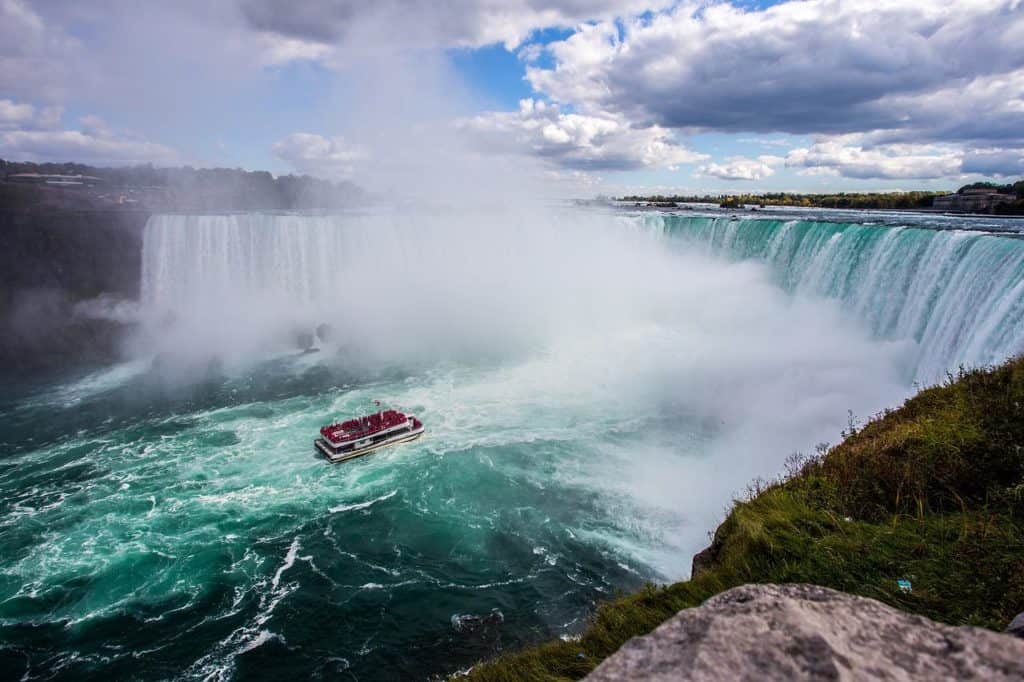
16. Facts About Niagara Falls and the English Wax Museum
When Louis Tussaud’s English-Tudor-style Wax Museum was opened in Niagara Falls in 1959, it changed the face of Niagara Falls completely. This museum includes 15 themed galleries with over 100 life-like wax figures. If you love taking selfies, look for the wax figure of your favourite actor, politician, or rock star and snap a selfie with it!
17. Facts About Niagara Falls’ Ice Bridges
Ice bridges form in the Niagara Gorge below the Falls in the 1800s and 1900s. The Gorge could become choked with slush, ice, and ice floes. This jammed ice would freeze into a solid mass and form the world’s popular ice bridges that provided visitors with unique views of Niagara Falls. In February 1912, ice bridges were closed after the tragic collapse of one of the ice bridges.
18. Facts About Niagara Falls and the Honeymoon Bridge
The Upper Steel Bridge is locally known as the Honeymoon Bridge or Fallsview Bridge. It was an international bridge that crossed the Niagara River, connecting Niagara Falls, Canada, and Niagara Falls, USA. This world’s largest steel arch bridge featured a double track for trolley cars and a space for carriages and pedestrians. It was closer to the American Falls than the current location of the Rainbow Bridge.
In January 1899, ice built up under the bridge and threatened it. Subsequently, the bridge was fortified. However, it collapsed in January 1938 due to a sudden wind storm on Lake Erie. This wind storm sent a massive amount of ice over the falls. The ice pushed against the bridge, resulting in the collapse of the bridge. Fortunately, the bridge was closed several days before in anticipation of the collapse.
19. Niagara Falls, Canada: The Honeymoon Capital of the World
Niagara Falls, Ontario, Canada, has been known as the Honeymoon Capital of the world for over 200 years. Every singly day, it brings in newlyweds on their honeymoon. This is because it is famous for the sound of waterfalls, romantic gateways, secluded picnic areas, fragrant flowers, greenery, lovely restaurants, and candlelight.
In the early 1800s, the French established Niagara Falls as the ideal honeymoon destination. Joseph and Theodosia Alston were among the first couples to spend their honeymoon in Niagara Falls. It has also been said that Napoleon’s brother, Jerome Bonaparte, went to Niagara Falls for his honeymoon. Other wealthy couples honeymooned in Niagara Falls, thus increasing the popularity of Niagara Falls as a honeymoon destination and decreasing its travel cost.
20. Facts About Niagara Falls and Honeymooners
Niagara Falls loves lovers. In Niagara Falls, Canada, honeymoon couples can get an official honeymoon certificate issued and signed by the Mayor. With this certificate, the bride can receive free access to several local attractions on the Canadian side of Niagara Falls. You can obtain this free certificate from the Visitor and Convention Bureau or the Ontario Tourism Information Centre.
On the other hand, in Niagara Falls, US, many hotels offer honeymoon and wedding anniversary discount packages. The package offers rose petal turn-down services, spa services, dining credits, and more. You just need to get a “We Honeymooned in Niagara Falls USA” certificate from the official Visitor Centre in Niagara Falls, US.
What Else is There to do in Niagara Falls Besides the Falls?
Niagara Falls is on the border of Canada and America. Apart from the falls, there are a lot of attractions and must-visit destinations with exciting activities and unique experiences in both Canada and America. With ConnollyCove, we will explore the best things to do in Niagara Falls, Canada and the best things to do in Niagara Falls, US.
Beautiful Pictures of Niagara Falls
Now, I will leave you with these astonishing pictures of Niagara Falls. Enjoy!
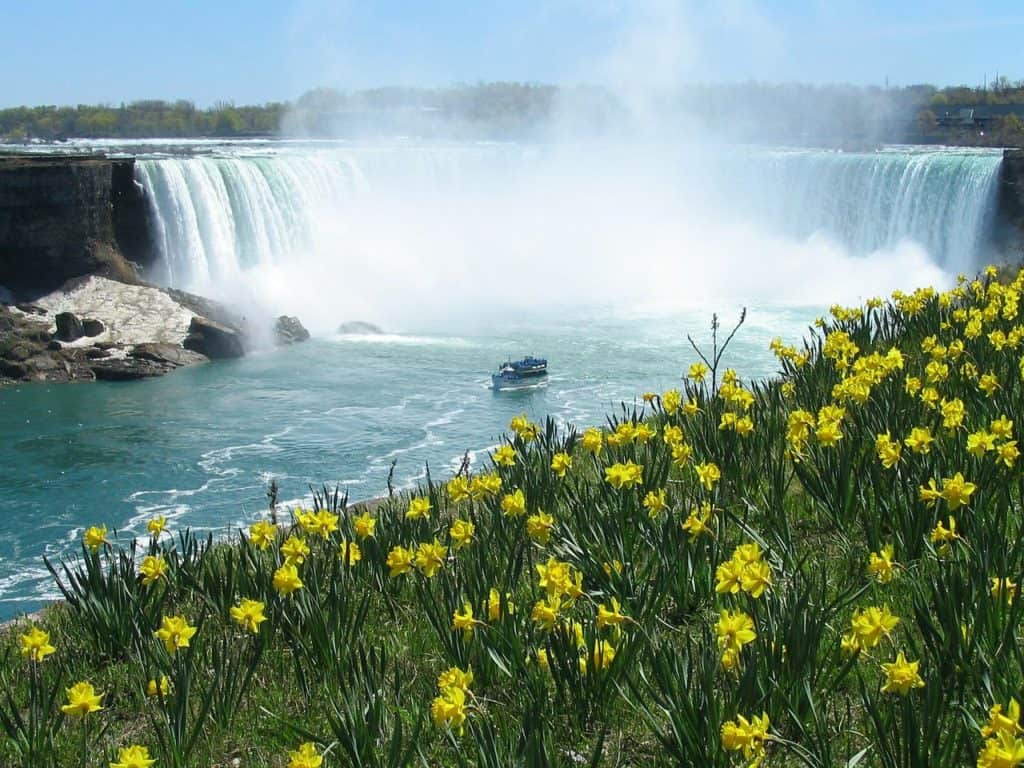
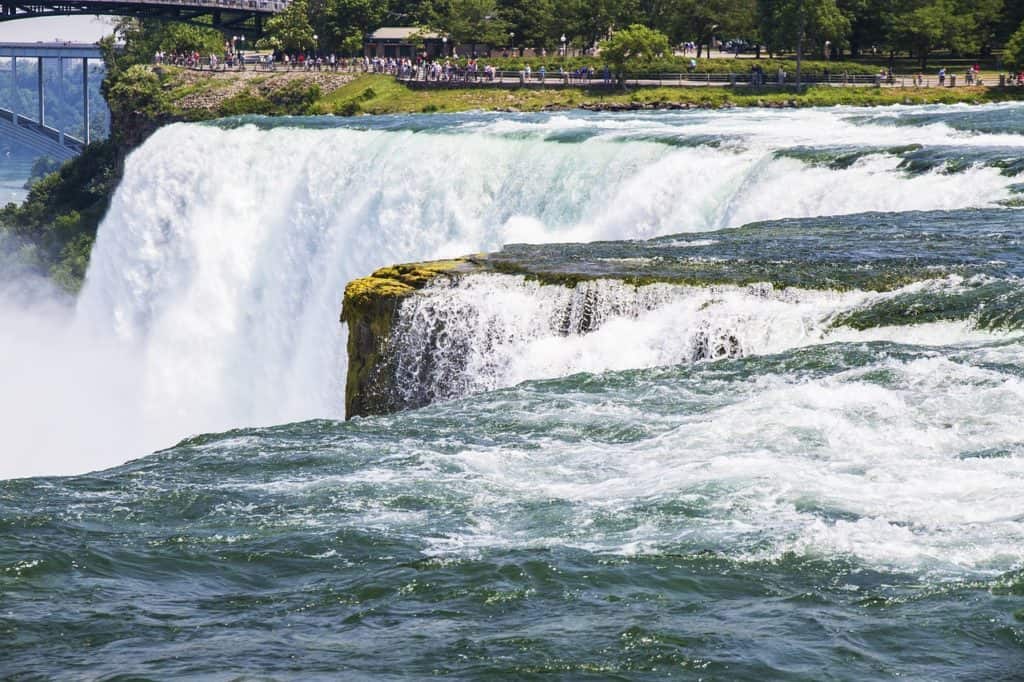
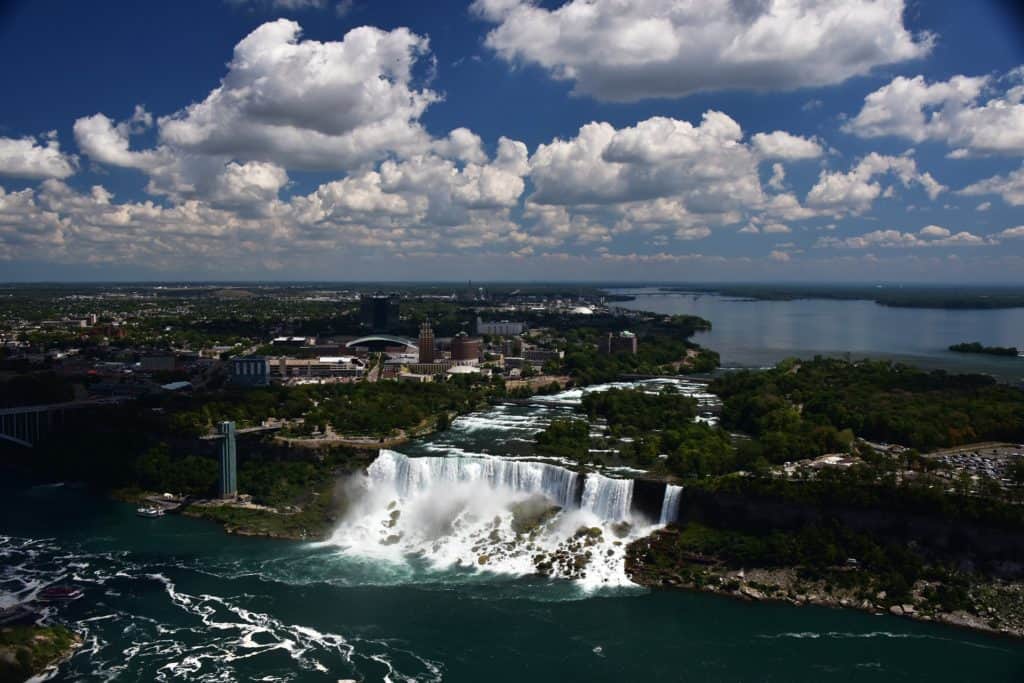
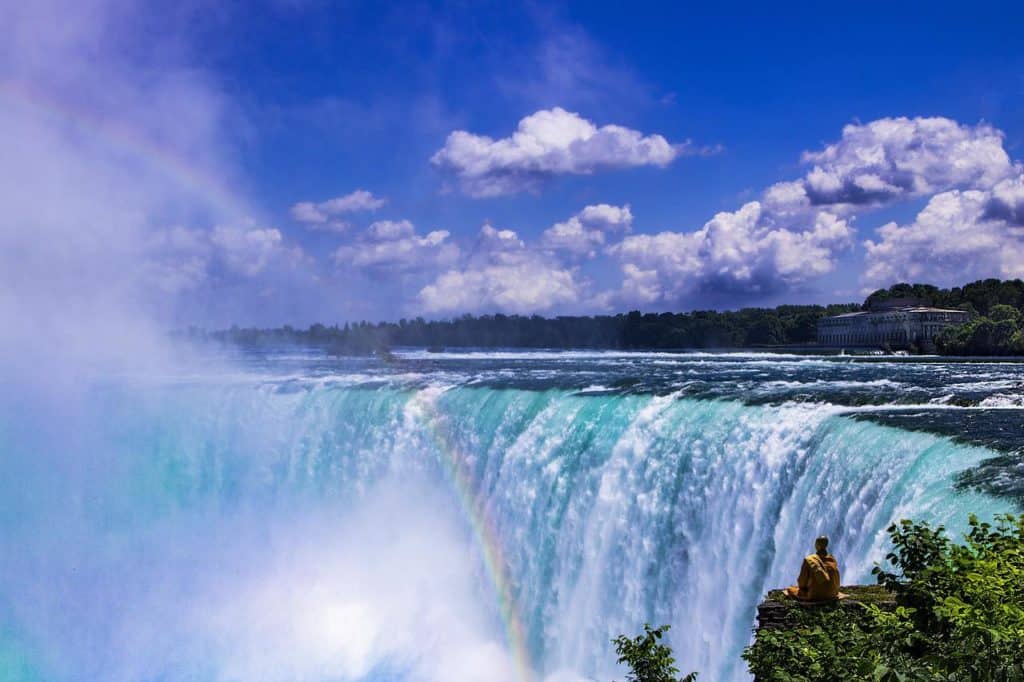
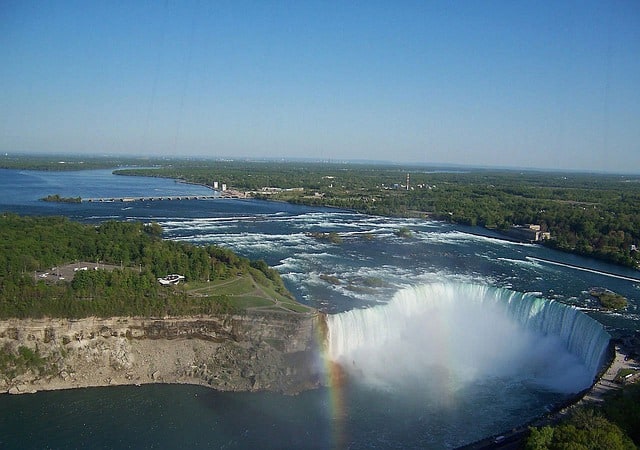
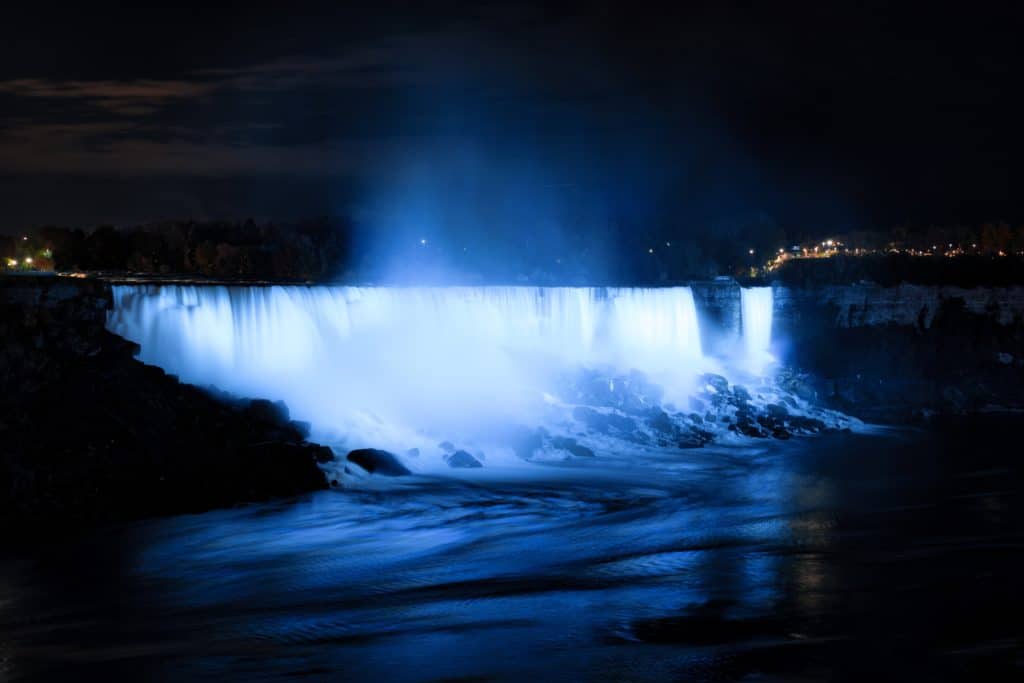
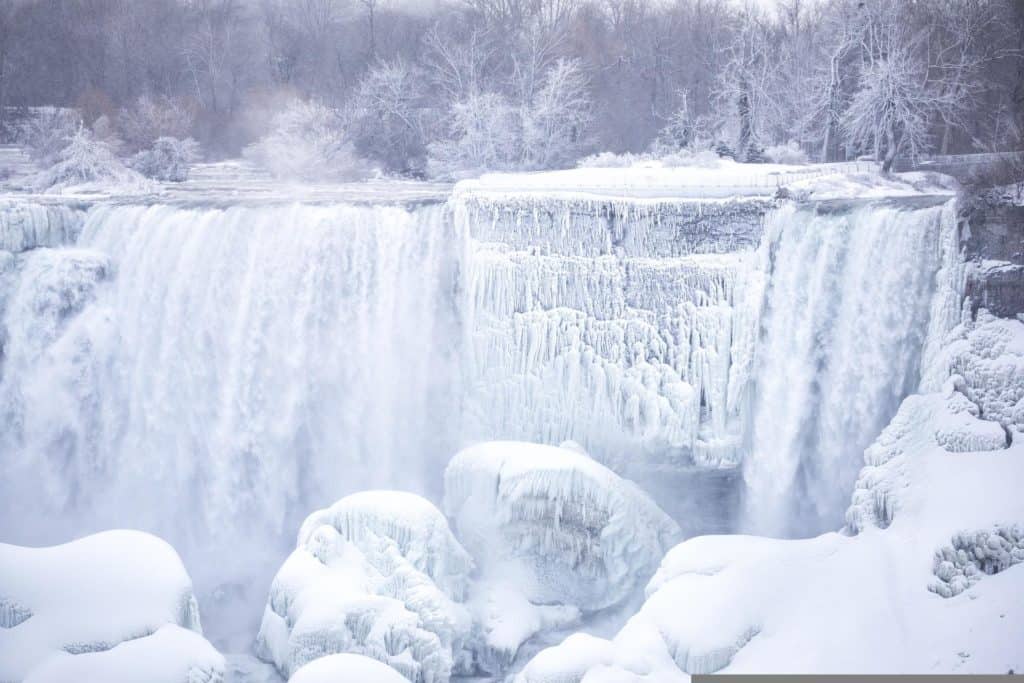

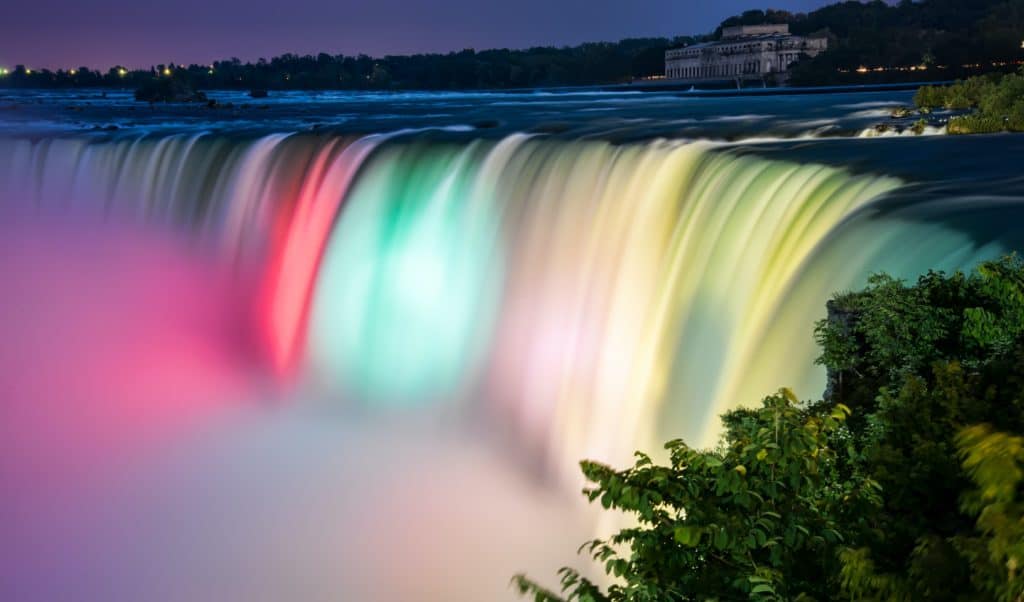
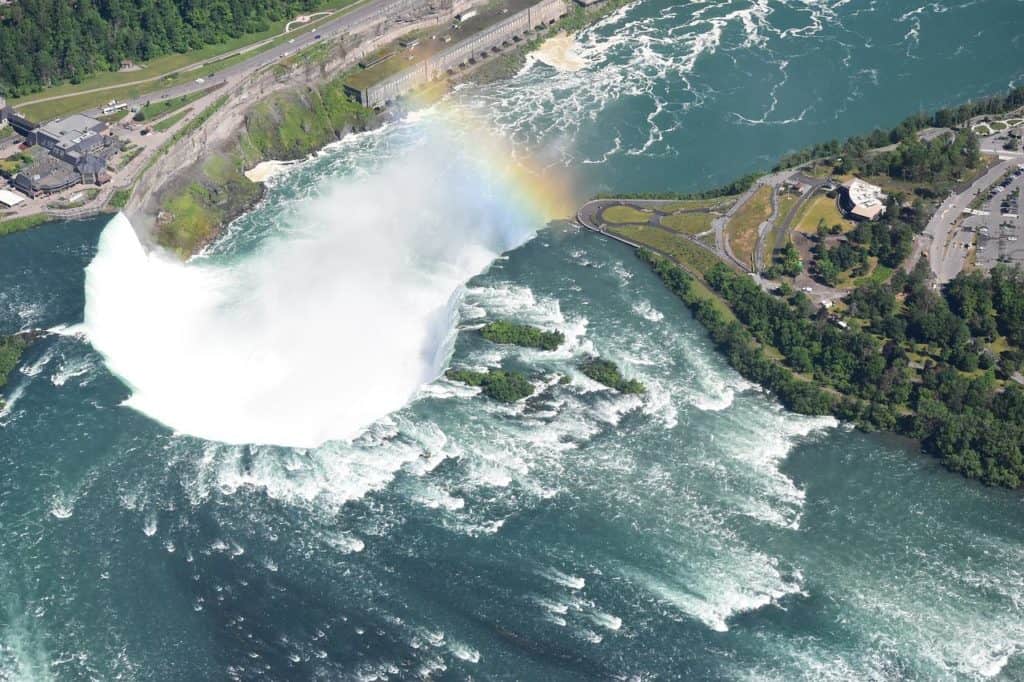

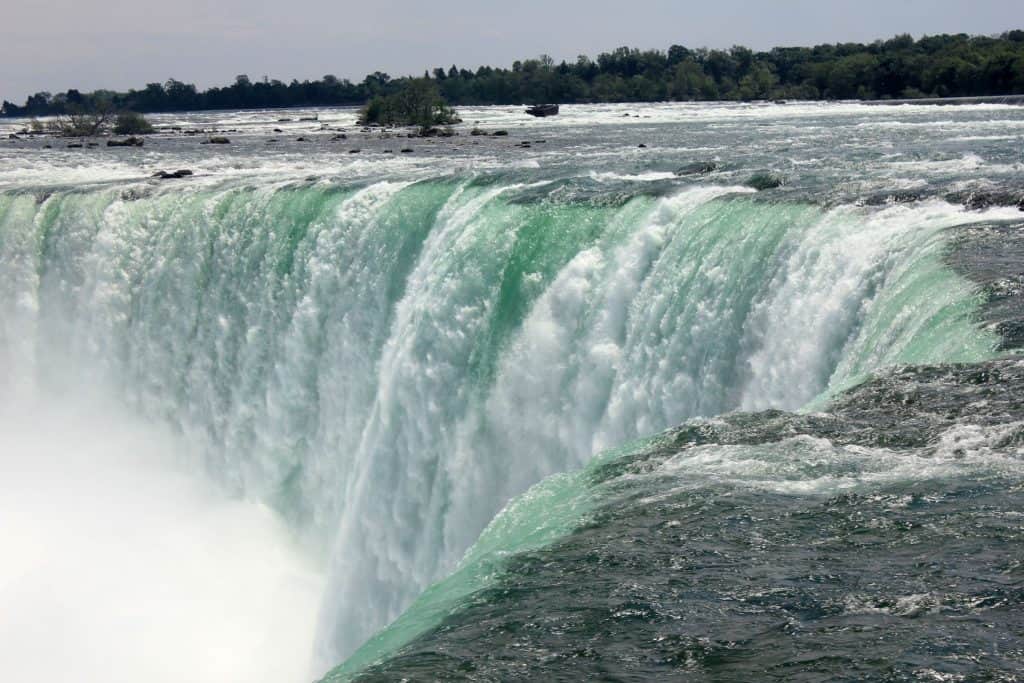

Niagara Falls has magical views and fantastic nearby attractions that you should visit at least once in your life. If you have not visited Niagara Falls yet, which side would you love to visit first: the Canadian or the American?






